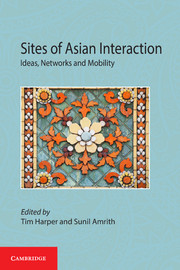Book contents
- Frontmatter
- Contents
- List of figures
- Preface
- Introduction
- 1 Singapore, 1915, and the Birth of the Asian Underground
- 2 Living in the Material World: Cosmopolitanism and Trade in Early Twentieth Century Ladakh
- 3 Nation, Race, and Language: Discussing Transnational Identities in Colonial Singapore, circa 1930
- 4 Intimate Interactions: Eurasian Family Histories in Colonial Penang
- 5 Citing as a Site: Translation and Circulation in Muslim South and Southeast Asia
- 6 Popular Sites of Prayer, Transoceanic Migration, and Cultural Diversity: Exploring the significance of keramat in Southeast Asia
- 7 Connecting People: A Central Asian Sufi network in turn-of-the-century Istanbul
- 8 ‘Enough of the Great Napoleons!’ Raja Mahendra Pratap's Pan-Asian Projects (1929–1939)
- 9 Chinatowns and Borderlands: Inter-Asian Encounters in the Diaspora
- 10 Creating Spaces for Asian Interaction through the Anti-Globalisation Campaigns in the Region
- Contributors
- Index
9 - Chinatowns and Borderlands: Inter-Asian Encounters in the Diaspora
Published online by Cambridge University Press: 05 July 2014
- Frontmatter
- Contents
- List of figures
- Preface
- Introduction
- 1 Singapore, 1915, and the Birth of the Asian Underground
- 2 Living in the Material World: Cosmopolitanism and Trade in Early Twentieth Century Ladakh
- 3 Nation, Race, and Language: Discussing Transnational Identities in Colonial Singapore, circa 1930
- 4 Intimate Interactions: Eurasian Family Histories in Colonial Penang
- 5 Citing as a Site: Translation and Circulation in Muslim South and Southeast Asia
- 6 Popular Sites of Prayer, Transoceanic Migration, and Cultural Diversity: Exploring the significance of keramat in Southeast Asia
- 7 Connecting People: A Central Asian Sufi network in turn-of-the-century Istanbul
- 8 ‘Enough of the Great Napoleons!’ Raja Mahendra Pratap's Pan-Asian Projects (1929–1939)
- 9 Chinatowns and Borderlands: Inter-Asian Encounters in the Diaspora
- 10 Creating Spaces for Asian Interaction through the Anti-Globalisation Campaigns in the Region
- Contributors
- Index
Summary
Chinatowns
It was in North America, in New York City on the east coast and San Francisco on the west coast, that ‘Chinatown’ came into the lexicon of American English. Both residential and commercial, these were ethnic enclaves imposed and enforced by the dominant society. While denied access to equal rights and political incorporation as ‘aliens ineligible for citizenship’, their denizens were needed for their cheap labour and the economic niche they created and occupied to meet the needs and desires of the larger society. Ironically, the Chinese Exclusion Act of 1882 only sealed the existence of Chinatowns as permanent enclaves, for it broke the pattern of ‘sojourning’—travelling back and forth—that had marked diasporic Chinese practices. Unable to return to the United States if they left, most chose to stay put, thus increasing and stabilising the Chinatowns population, ensuring its survival for many decades. Long after enforced residential segregation ended, Chinatowns have persisted in the United States as tourist magnets, representing an Orientalism of both desire and repulsion in the popular American imagination.
American Chinatowns reinvented themselves as a new kind of ethnic enclave when immigration reform in 1965 facilitated the entry of new immigrants from Asia after a long period of exclusion. Renewed immigration coincided with the dawn of a new era of globalisation, marked by deindustrialisation in the global core—the United States—and an innovative development strategy called ‘export-based industrialisation’ in the global periphery.
- Type
- Chapter
- Information
- Sites of Asian InteractionIdeas, Networks and Mobility, pp. 191 - 215Publisher: Cambridge University PressPrint publication year: 2014

